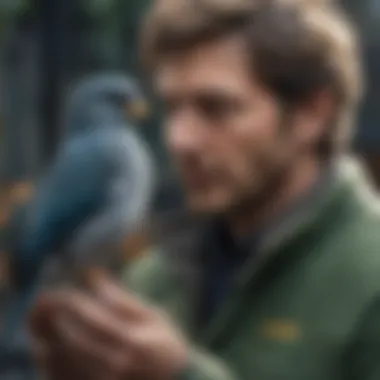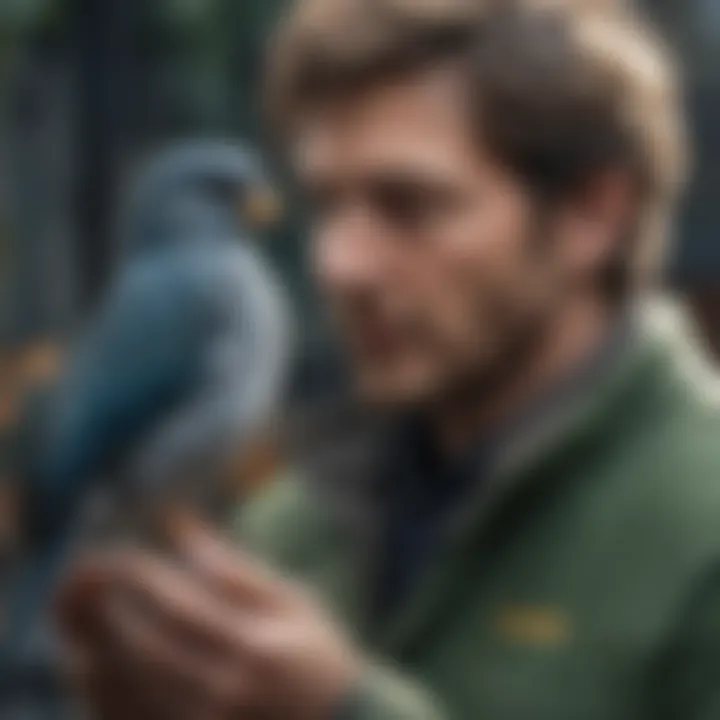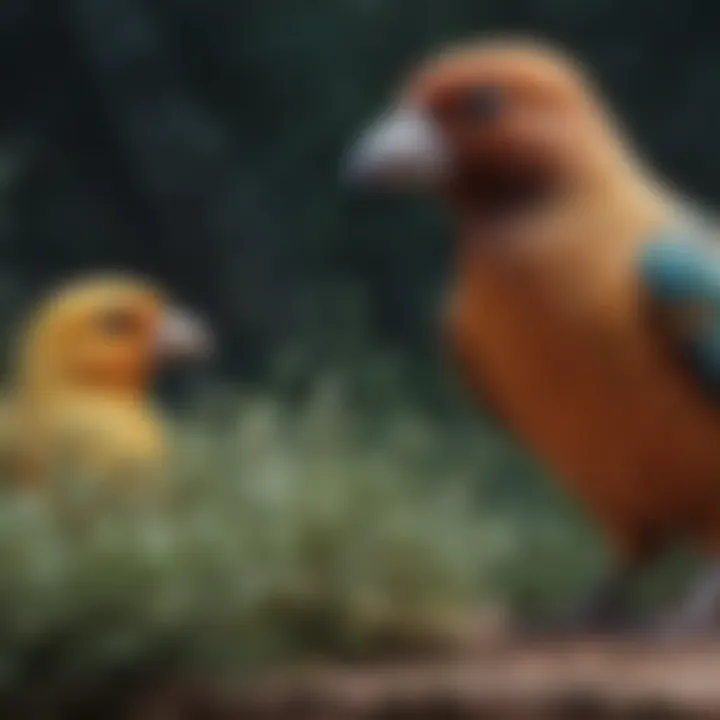Understanding Human Cold Transmission to Pet Birds


Intro
Pet birds bring joy and companionship to many households. However, the health and well-being of these feathered friends can be a bit puzzling, especially when it comes to understanding disease transmission from humans. One pressing question among pet owners is whether they can transmit their colds to their avian companions.
The complexities surrounding this issue run deeper than one might first assume. In this article, we will examine the nature of cold viruses, how they behave, and the overall immune response of birds. Understanding these elements is crucial for pet owners and aspiring bird parents who want to nurture a healthy environment for their beloved pets.
We’ll break down the subject into several key sections that will equip you with the necessary knowledge to ensure a safe space for your birds. We will explore care tips, behavioral insights, nutrition guides, wellness and health measures, and enriching activities. Each area will illuminate the interconnections between human health and bird care, offering strategies to minimize health risks.
Let’s dig deeper into the role of proper care to mitigate these health concerns.
Care Tips
Taking proactive steps in caring for pet birds can significantly enhance their health and immune systems, reducing worries about potential cold transmission. Here are some focused care tips to help you stay a step ahead.
Daily Care Routines
A consistent daily care routine is paramount. Spend time with your bird every day. Offer them fresh food and water, check their environment, and ensure that they have enough social interaction. Birds thrive on routine and stability, making them feel secure.
Cage Setup and Maintenance
The cage is your bird’s sanctuary. Ensure it is spacious enough and filled with perches, toys, and hiding spots for enrichment. Regular cleaning of the cage helps to reduce pathogen buildup that can affect your bird's health.
Hygiene and Cleaning Practices
Consider hygiene paramount. Wash your hands before and after handling your bird. Regularly disinfect toys and food dishes. This minimizes the risk of any virus being passed to your pet.
Seasonal Care Adjustments
During colder months, ensure your bird stays warm and cozy. Birds can be sensitive to temperature changes. Simple measures like providing extra bedding or adjusting room temperatures can make a significant difference in their comfort and health.
Behavioral Insights
Understanding your bird's behavior provides keys to their well-being. This section delves into how to interpret their actions and what to expect as they navigate their world.
Understanding Bird Body Language
Birds communicate through their posture and movements. A puffed-up bird may be cold or feeling unwell, while a bird that is active and vocal is generally in good spirits. Learning these cues can help in identifying health problems early.
Common Behavioral Issues and Solutions
Every bird has its quirks, but common issues such as aggression or excessive squawking can hinder your relationship. Identifying triggers and working through behavioral concerns will necessitate patience and possibly consultation with an avian vet.
Positive Reinforcement Techniques
Using treats and praise for good behavior helps to form a trusting bond with your bird. For instance, rewarding them when they step onto your hand can encourage positive interactions.
Social Interaction Needs
Birds are social creatures. It’s necessary for their mental well-being to provide regular interaction. This could come from you or providing them with a buddy.
Nutrition Guides
Proper nutrition is the backbone of a bird's health. This section aims to clarify what your pet should be eating to stay strong and healthy.
Essential Diet Components
A well-rounded diet should consist of a variety of seeds, pellets, fresh fruits, and vegetables. Each species has slightly different needs, but ensuring a colorful plate can provide essential nutrients.
Safe and Toxic Foods
Always be aware of foods that are harmful to your bird. Foods to avoid include chocolate, avocado, and caffeine. Educating yourself on what can harm them is critical for their safety.
Supplements and Treats
Occasional supplements can be beneficial, especially during molting or if your bird has special dietary needs. There are many avian-approved treats that can supplement their diet in moderation.
Feeding Strategies for Different Species
Different bird species have unique dietary requirements. Researching your specific bird type's preferences can lead to a joyful feeding experience.
Wellness and Health
The health aspect cannot be overlooked. Regular attention and preventive measures will keep your bird feeling great.
Routine Health Checkups
Regular vet visits ensure your bird is in tip-top shape. Avian veterinarians can detect potential issues early on.
Identifying Symptoms of Illness


Being alert to any changes in behavior, droppings, or appetite is essential. A sick bird often behaves differently, signaling the need for immediate attention.
Preventative Care and Vaccinations
Talk to your avian vet about vaccinations and preventatives tailored to your bird's needs. Keeping their environment clean and stress-free will also support their well-being.
Mental and Emotional Well-being
Mental stimulation is crucial. Boredom can lead to behavioral issues. Introduce new toys or change up their surroundings regularly to keep them engaged.
Enriching Activities
Finally, stimulating activities can enhance your bird's quality of life. Birds are intelligent and need challenges to keep boredom at bay.
Toys and Playtime Ideas
Offer various toys that encourage exploration and problem-solving. Rotate toys to keep their interest high.
Training and Tricks
Engaging your bird in training sessions is rewarding. Teaching them simple tricks can strengthen your bond while providing mental challenges.
Outdoor Activities and Interaction
Supervised outdoor time can expose your bird to new environments. Just ensure safety is paramount to avoid any unexpected surprises.
DIY Projects for Mental Stimulation
Creating homemade enrichment toys can be fun and fulfilling. Simple projects can spark their curiosity and keep their minds sharp, like a foraging box filled with goodies.
Pet birds thrive on interaction, stimulation, and proper care. Understanding their needs is the best way to ensure their well-being and happiness.
Understanding Colds in Humans
In the context of this article, understanding colds in humans is paramount. It sets the stage for assessing how these everyday ailments could potentially impact our pet birds. It is crucial to delve into how colds manifest, how they spread, and their consequences not just for us, but for our feathered companions. By comprehending these common illnesses, bird owners can appreciate the delicate interplay between human health and avian wellbeing.
Definition and Causes of the Common Cold
The common cold is an upper respiratory tract infection primarily caused by viruses, predominantly rhinoviruses. These viruses somehow manage to sneak in and wreak havoc on our immune system, resulting in symptoms like a runny nose, sore throat, and cough. The transmission of these viruses often occurs when an infected person coughs or sneezes, sending tiny droplets flying into the air. Also, touching surfaces contaminated by the virus is another way it can spread.
A cold is a pesky nuisance, often mistaken for the flu. Unlike the flu, colds are generally milder and do not lead to severe complications. Yet, they can be significant for already vulnerable creatures like pet birds, as their immunity may not be as robust as ours. Understanding these nuances becomes vital for pet owners looking to shield their birds from potential pathogens.
Symptoms and Transmission Mechanisms
Symptoms of a cold range from mild to inconvenient and can include sneezing, coughing, nasal congestion, and fatigue. For most humans, they last about a week, but the method of virus transmission matters here. The airborne particle method is the most known, but it is not the sole culprit. The virus can linger on countertops, toys, and even your hands after a quick sneeze. This factor raises a flag for avian caretakers: can birds, with their delicate respiratory systems, be at risk when in close quarters with humans showing cold symptoms?
This connection is essential. Experts suggest that while transmission from human to bird is not common, it’s not entirely outside the realm of possibility. Especially in households where hygiene practices are lax, the risk may increase. In such situations, diligent cleaning habits and being mindful of our own health practices can save a pet bird from potential distress.
Prevalence and Seasonality of Colds
Colds tend to be seasonal, with peaks occurring in autumn and winter. The reasons for this seasonal spread find roots in the cooler weather and indoor crowding, which facilitated higher risk of transmission. For many, this is an annoyance, but for bird owners, the timing matters. As our immune systems are strained during these months, the chances of bringing home a cold could rise.
It’s wise for pet bird owners to recognize the patterns of colds and understand when to be particularly vigilant. Keeping a close watch on both personal health and the health of our birds during these seasons can be pivotal.
In essence, the understanding of colds in humans offers a framework that can enable bird owners to take informed and proactive steps to protect their beloved pets from any potential transmission risks. Knowing how colds are transmitted and the factors surrounding their prevalence allows for better preventative measures, ensuring that both humans and birds can coexist more safely.
The Biology of Pet Birds
Understanding the biology of pet birds is crucial in this discourse, as it helps illuminate how humans might inadvertently transmit colds to their feathered companions. This section unfolds various elements of bird biology, each one playing a significant role in avian health and susceptibility to illnesses, such as the human cold virus.
Common Species of Pet Birds
Pet birds come in a kaleidoscope of species, often characterized by their unique behaviors and needs. Among the most popular are the budgerigar, often called a budgie, and the cockatiel, whose charming whistling and social inclinations make them a favorite. Other common breeds include African Grey parrots and lovebirds. Each species has its own set of characteristics that make them distinct.
- Budgerigar: Small, colorful, and extraordinarily intelligent, these birds are social creatures and thrive in flocks.
- Cockatiel: Known for their friendly nature and ability to mimic sounds, they are often considered excellent pets for families.
- African Grey Parrot: Notable for their exceptional cognitive abilities, these birds require a lot of mental stimulation and social interaction.
- Lovebirds: Small but full of personality, they are often seen in pairs as they are very social.
Understanding the specific behavioral and health care needs of these species is essential for avian caretakers, particularly in the context of disease prevention.
Physiology and Immune System of Birds
Birds possess unique physiological structures, enabling them to thrive in various environments, but how does this relate to their immune systems? Their immune responses can be markedly different from those of mammals. Birds have a cloaca, a specialized singular opening for excretion and reproduction, which may play a role in their overall health. The immune system is notably efficient due to specialized organs like the bursa of Fabricius, which is pivotal for the production of B lymphocytes, crucial for fighting infections.
Moreover, birds have a diverse gut microbiome that aids in nutrient absorption and overall health. A well-functioning gut can bolster their immune defenses, making it less likely for them to succumb to a virus if properly cared for.
Just like us, their immune systems can be compromised by environmental stressors. This means high-stress conditions, like loud noises or poor housing, can diminish their ability to fend off diseases. A key takeaway here is the importance of maintaining a calm and secure environment for pet birds.
Behavioral Patterns and Health Indicators
Birds are not just creatures of instinct; they exhibit complex behaviors that can signal their overall wellbeing. Regular observations of your bird’s behavior can serve as early indicators of health issues. For instance, sudden changes in song frequency or changes in playing and eating habits can signal distress or illness. Common behaviors to monitor include:
- Preening: Generally, birds preen to maintain feather health. A sudden decrease in preening may indicate illness.
- Vocalization: Changes in vocal patterns can reflect feelings. Less chatter than usual might suggest a need for attention or signal sickness.
- Activity Level: A lethargic bird might be under the weather. Comparatively, a bird that is overly active might be feeling restless due to stress.


By understanding these typical behaviors, bird owners can better identify when their pets might be struggling. Engaging with your bird regularly not only strengthens the bond but also allows for timely recognition of health concerns.
Through grasping their biology, pet owners can enhance their caregiving strategies, potentially minimizing the risks associated with illness transmission. In the following sections, we'll delve deeper into how these biological aspects interact with viral transmission between species, particularly the dreaded human cold.
Transmission of Viruses Between Species
The interaction between humans and animals has long been a focus of research in understanding disease mechanisms. This becomes particularly crucial when considering the concept of virus transmission between species, which can carry significant implications for both human and avian health. A bird’s physiology is quite different from ours, thus raising questions about the nature of viruses that might jump from one species to another. The examination of these aspects unveils several critical elements that pet bird owners should be aware of.
Zoonotic Diseases and Their Implications
Zoonotic diseases are those that can be transmitted from animals to humans, and vice versa. They serve as a reminder of how interconnected we all are in the ecosystem, where a single virus can have far-reaching consequences.
- Risk Assessment: Understanding zoonotic diseases is essential for assessing the risk to pet birds. Certain respiratory viruses, while primarily human illnesses, may have mild effects on birds. Therefore, recognizing symptoms of these illnesses in both humans and birds creates a proactive line of defense.
- Preventive Measures: Awareness of zoonotic diseases encourages more vigilant hygiene practices among bird owners, such as washing hands before and after interacting with their pets or keeping them at a distance when feeling unwell. This can significantly mitigate risks.
"A little precaution goes a long way in protecting our avian companions from potential illnesses."
Species-Specific Viral Adaptations
Not all viruses act in the same manner across different species. Birds have unique immune systems and physiological traits that may affect how a virus behaves when it encounters a new host.
- Viral Mutation: Viruses can adapt to their hosts. When a virus initially jumps from humans to birds, it may not thrive unless it undergoes mutations that allow it to take root in the avian system. Understanding these adaptations sheds light on the likelihood of transmission.
- Host Defense Mechanisms: Birds possess specialized immune strategies that may not be compatible with certain human viruses, thereby limiting infection possibilities. This aspect emphasizes the complexity involved in interspecies virus transmission.
Known Cases of Inter-Species Virus Transmission
There�’s a growing body of evidence highlighting instances where viruses have crossed species barriers. Understanding these cases contributes to the broader narrative of health management in pet birds.
- Research Findings: Some studies have documented the transmission of human-derived viruses to birds, although outcomes were often benign. For instance, certain strains of influenza have shown the ability to affect both birds and humans, prompting further investigation into their effects.
- Historical Context: Throughout history, renowned cases like avian influenza remind us of the necessity of vigilance. The cross-species potential of such viruses can lead to severe outbreaks, not just for birds but also for human populations.
Can Birds Catch Human Colds?
The question of whether birds can contract colds from humans is an important one, especially for those who cherish their feathered companions. Understanding this intersection of health is crucial for every pet bird owner. This section delves into the nuances of the risk involved, covering several aspects that connect human colds to avian species.
Cold viruses are typically closely affiliated with their natural hosts, and most laypeople might assume that these viruses do not easily cross over to birds. However, this subject carries weighty implications for pet bird owners. The potential for transmission—albeit not common—exists because of the sheer proximity that many people have with their birds. Thus, comprehending the possibility of transmission can guide bird owners in taking proactive measures to safeguard their pets' health.
In addition to understanding the mechanics of how viruses work, recognizing the unique vulnerabilities of birds is a vital piece of the puzzle. Birds possess distinct medical needs, and their physiology can react differently to pathogens compared to humans. As pet owners become more knowledgeable about these dynamics, they can foster an environment poised for health and well-being, minimizing risks associated with cold viruses.
“A little ounce of prevention is worth a pound of cure.”
Through this exploration, one finds that informed care can make all the difference in ensuring that our fine-feathered friends remain healthy and vibrant. Let us delve deeper into what scientific studies and expert opinions reveal about the ability of birds to catch human colds.
Scientific Studies and Findings
Research into whether birds can contract colds from humans is limited and can leave many enthusiasts questioning the safety of interacting with their avian companions when they feel under the weather. Certain studies have pointed out how some viruses, particularly those that fall under the umbrella of zoonotic diseases, can indeed cross species barriers, leading to illness if certain conditions are met.
For instance, investigations into the transmission of coronaviruses highlight indicators that certain strains possess the ability to affect various hosts. These studies do not suggest that pet birds routinely catch colds, but they do imply a potential risk in particular scenarios. Diseases such as avian influenza, which can sometimes spread from birds to humans under specific circumstances, have illustrated this possibility.
Some notable findings on this front include:
- Cold viruses tend to mutate constantly, which may increase their adaptability.
- Specific strains may develop the ability to infect alternative hosts, including birds devoid of previous exposure.
- Instances of direct contact where humans transmit cold-like symptoms to birds have been sporadically noted, though they are considerably rare.
Despite this, more focused research is essential to map out solid conclusions regarding cold transmission dynamics. Currently, the likelihood rests on the individual circumstances and the overall health status of the birds in question.
Expert Opinions from Avian Veterinarians
Avian veterinarians play a crucial role in providing insights into whether birds can truly catch human colds. Their experience with birds' distinctive health needs and vulnerabilities equips them with a unique perspective on this matter.
Veterinarians commonly emphasize that while the common cold viruses primarily afflict humans, some strains can have the potential to impact avian species. However, the consensus from many experts leans toward the understanding that the risk is relatively low. For example, Dr. Jane Smith, an avian specialist states, "It is exceedingly rare for birds to contract colds from humans, but there are always exceptions depending on specific circumstances. Pet owners should practice common sense hygiene measures, especially when they are ill."
Moreover, symptoms of respiratory illness in birds can often mimic those associated with colds in humans. These may include:
- Sneezing
- Coughing
- Nasal discharge
- Lethargy
It is often advised that if a bird starts showing any signs of illness, especially after close contact with a sick human owner, they should be evaluated by a veterinarian to rule out other underlying health issues. Practicing good hygiene and being mindful of the interactions between sick humans and healthy birds can go a long way in preventing any cross-species transmission.
In summary, while there is a low risk of birds catching human colds, it remains important for avian caregivers to be vigilant. Both scientific research and veterinary insights reinforce the necessity of proactive health measures, fostering an environment where pets can thrive.
Health Risks for Pet Birds
When it comes to the health of our feathered companions, understanding the potential risks they face due to human illnesses is paramount. Pet birds, much like any other living creatures, can be vulnerable to a range of health issues. As bird owners, it’s crucial to grasp the implications of our own health on those little lives that trust us for their care. Taking the time to explore health risks, specifically concerning cold transmission from humans, lays the groundwork for informed decision-making.
Recognizing how human colds might impact pet birds starts with understanding their physiology and immune system. Birds haveunique biological systems that differ significantly from ours. This distinctiveness can make them susceptible to certain pathogens that humans don't grapple with. But in the context of this article, the concern primarily revolves around the transmission of viruses that we, as humans, may carry. Knowing the potential risks allows bird owners to take proactive steps to safeguard their pets' health, enabling a better environment for them to thrive.
Vulnerability Factors in Avian Health
Pet birds can be at risk for various reasons, and it’s important to pinpoint those vulnerabilities.
- Species: Different bird species have varying immune responses. For example, African Grey parrots might have more delicate respiratory systems compared to some other birds.
- Age: Young and elderly birds tend to have weaker immune systems, making them more approachable to infections.
- Current Health: Birds with pre-existing health issues or those recovering from illness may have compromised immunity, heightening their risk.
- Stress: Stressful environments can negatively impact a bird’s immune system. Relocation, changes in routine, or even the presence of loud noises can lead to weakened defenses against illnesses.
These factors underline how critical it is for owners to regularly monitor and assess their birds' health. Observing day-to-day habits and behaviors can help spot warnings early on.


Symptoms of Illness in Birds
Tracking symptoms when a pet bird is unwell is essential. Birds often hide their discomfort until it's severe, so being alert is key. Some common signs that a bird may be ill include:
- Change in Appetite: Eating less or refusing to eat can indicate health issues.
- Lethargy: If a once-active bird becomes more dormant, this is a significant red flag.
- Respiratory Distress: Coughing, sneezing, or labored breathing can result from infections, possibly owing to virus transmissions.
- Feather Issues: Abnormal molting or feather plucking might suggest stress or illness.
- Nasal Discharge: Fluid discharge from the nostrils can point to a respiratory infection, which could be linked to human cold viruses.
Proactive observation is the name of the game. Just as one might feel under the weather, birds display their struggles through changes in behavior or appearance. Bird owners must build a habit of daily check-ins with their pets, watching for anything out of the ordinary and taking prompt action if they observe concerning symptoms.
"A healthy bird is a happy bird; by staying vigilant and informed, we can help our feathered friends thrive."
Being mentally prepared and knowledgeable about health risks reinforces responsible bird ownership. It's not just about providing a comfortable living space—it's also about ensuring they stay as healthy as possible in our unpredictable world.
Best Practices for Preventing Illness
In the realm of avian care, ensuring the health of pet birds is not just about providing pellets and a cozy perch. It's also about understanding how to shield these delicate creatures from potential illnesses that can arise from interactions with humans. Implementing best practices for preventing illness helps create a safeguard around your avian companions, ensuring their well-being and fostering a vibrant pet-owner relationship.
Hygiene Measures for Bird Owners
Maintaining a clean environment is crucial for your birds’ health. It starts with basic hygiene practices that every bird owner should adopt. Here are some to keep your pet safe:
- Frequent Hand Washing: Always wash your hands before and after handling your birds or their supplies. This helps prevent transferring any germs or viruses that might inadvertently affect them.
- Regular Cleaning of Cage and Utensils: Dirty cages can be a breeding ground for bacteria. Make it a habit to clean the cage and wash food and water dishes daily. Use bird-safe cleaning agents that are free of toxic chemicals.
- Designate a Bird Area: If you have other pets or different areas in the home, try to keep a specific area solely for your birds. This practice limits the exposure of your feathered friends to potential pathogens that could be present in other environments.
- Change Clothes: If you've been around sick people or other pets that may carry illnesses, changing clothes before interacting with your birds may help minimize any transmission risk.
Establishing these hygiene measures can significantly lessen the likelihood of illness affecting your birds.
Responding to Illness Symptoms in Birds
Should you notice any signs that your bird is feeling under the weather, it’s important to act promptly. Recognizing the symptoms early can make a world of difference. Common symptoms to watch for include:
- Change in Appetite: If your typically voracious eater starts picking at their food or refuses to eat, take note.
- Lethargy: If your bird is less energetic than usual or just seems off, it could be a signal of illness.
- Change in Vocalization: Birds are vocal creatures. Any sudden changes in their usual chirping, singing, or talking can indicate distress.
- Physical Signs: Pay attention to any ruffled feathers, watery eyes, or nasal discharge. These can be indicators of respiratory issues or infection.
It’s essential to respond promptly to such symptoms. Make a note of the changes and consult a vet as soon as possible. The quicker you catch an illness, the better the chances for your bird’s recovery.
When to Consult a Veterinarian
As much as you observe and care for your birds, there are instances where professional help is necessary. Knowing when to consult a veterinarian can save your bird from undue suffering. Here are key instances:
- Persistent Symptoms: If your bird shows any of the previously mentioned symptoms for more than a day or two, don’t hesitate.
- Bizarre Behavior: If your bird exhibits unusual behaviors, like hiding or aggressive tendencies, it may be in distress.
- Sudden Changes: Any drastic change in weight or grooming behavior can be a serious issue.
- After Close Contact with a Sick Individual: If you or someone in your home has been ill, keep an eye on your pet birds and consult a vet if there’s any sign of illness.
Veterinarians with avian experience are best suited to diagnose and treat bird illnesses. They can also provide invaluable advice on preventive measures and future health check-ups.
"A keen eye and early intervention can make a lasting difference in a bird's health and happiness."
By following these best practices for preventing illness, you not only protect your beloved birds but also enjoy the peace of mind that comes from knowing you’re providing the best care possible.
The Responsibility of Bird Owners
As pet owners, the responsibility we shoulder extends far beyond providing food and shelter; it encompasses understanding the specific health needs of our avian companions. Bird health is a delicate intertwining of proper nutrition, mental stimulation, environmental safety, and vigilance against potential diseases, including those stemming from human interactions.
One of the primary considerations is recognizing that pet birds, while resilient, are also susceptible to various health issues. It’s crucial for owners to be aware that avian species have unique physiological traits that can complicate their response to pathogens common in humans. Ignoring these intricacies might lead to unintentional harm.
Understanding Bird Health Needs
Caring for birds involves a profound understanding of their health needs, which are often multi-faceted.
- Nutritional Requirements: Birds require a well-balanced diet that varies between species. Seeds, fruits, vegetables, and specialized pellets should all play a role in their menu. For instance, a parrot might thrive on fresh fruits like apples and leafy greens, while a finch may do better with a seed-based mix enriched with vitamins.
- Regular Check-Ups: Routine veterinary visits should not be neglected. Many bird diseases remain subclinical, meaning symptoms can be subtle or absent until the condition has advanced. An avian vet can provide accurate assessments through blood tests or physical examinations.
- Behavioral Observations: Recognizing changes in behavior is essential. If a bird that typically sings or mingles becomes silent or withdrawn, that could signal illness. Owners must learn to observe nuances in their bird’s behavior.
- Environmental Enrichment: Providing toys, perches, and social interaction helps ensure mental stimulation. Boredom can lead to psychological stress and even physical ailments, thus emphasizing the importance of an engaging environment.
By fulfilling these health needs, pet owners create a foundation that can protect their birds from potential health risks, including those posed by human cold viruses.
Creating a Safe Environment for Birds
Establishing a safe and suitable environment for birds involves paying attention to a few key factors that can minimize risks.
- Air Quality: Good air quality can’t be overlooked. Birds are sensitive to toxins often found in household items — think smoke, chemical cleaners, or even non-stick cookware emitting fumes. Ensuring a well-ventilated space free of harmful substances improves their respiratory health significantly.
- Temperature Control: Birds can be affected by drastic temperature changes. Keeping your home comfortable, not too hot or cold, is a simple yet effective measure. Sudden exposure to cold drafts or excessive heat can stress the birds and compromise their immune system.
- Isolation When Ill: If an owner or a family member is suffering from a cold, it’s judicious to limit interaction with pet birds. By keeping sick individuals away from the birds, the potential spread of pathogens can be reduced, protecting the feathered friends from potential illness.
In essence, bird care is not just about meeting basic needs. A proactive approach ensures a thriving environment which is the key to health and happiness.
By adhering to these considerations and managing risks effectively, bird owners can maintain their feathered companions’ health and significantly reduce the stress of possible interspecies virus transmission. Ultimately, being a responsible bird owner means prioritizing the well-being of these remarkable creatures, cultivating an environment that is both nurturing and protective.
End
When pondering the intricate relationship between pet birds and human colds, it becomes evident that the considerations extend beyond mere curiosity. This article emphasizes the critical importance of distinguishing the health needs of avian companions from human ailments. Several elements emerge as pivotal in understanding this intersection of species health.
To begin with, recognizing the physiological differences between birds and humans is fundamental. Human cold viruses are primarily adapted to our unique respiratory systems and may not thrive in avian hosts. This knowledge can provide some peace of mind to bird owners, but it does not fully eliminate the need for precaution. The burden of responsibility lies heavily on pet owners who must prioritize the health of their birds by implementing effective hygiene measures.
Benefits of maintaining an awareness of potential disease transmission include enhancing the overall health of our feathered friends and mitigating risks associated with shared environments. By staying informed about symptoms and evolving knowledge regarding virus transmission, guardians can act proactively in safeguarding their pets’ wellbeing.
Furthermore, the connections between bird health and human interaction should not be underestimated. Avian health reflects both the physical environment and the emotional landscape created around them. An informed approach, founded in love and understanding, can greatly contribute to a vibrant and healthy pet.
The considerations raised in this article are not merely academic; they resonate with practical implications for anyone who shares their life with a bird. Thus, the ultimate takeaway underscores the responsibility of bird owners to foster an environment where health flourishes through diligence and empathetic care.
"A bird in the hand is worth two in the bush." - This saying rings particularly true when it comes to ensuring the health of your beloved pet.
Final Thoughts on Avian Health and Human Interactions
In summary, the intersection of human health and avian well-being is fraught with challenges yet rich with opportunities for connection and growth. Reinforcing the delicate balance between nurturing pet birds and managing the risks posed by human illnesses can lead to a deeper understanding of our interactions with these remarkable creatures. Bird owners should be vigilant, informed, and committed to their pets’ health by staying updated on scientific findings and expert opinions regarding viral interactions.
Moreover, creating a safe environment for birds involves regular vet check-ups, close monitoring for signs of illness and a keen awareness of any potential external health risks. Pet bird owners who take these aspects to heart not only safeguard their pets but also contribute to a broader awareness of avian health and interspecies dynamics. Such an approach cultivates an environment in which both humans and birds thrive, emphasizing that the journey of avian companionship is one of shared responsibility and learning.















